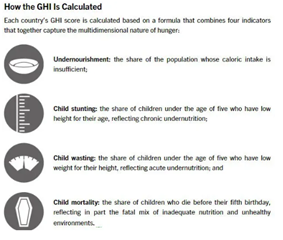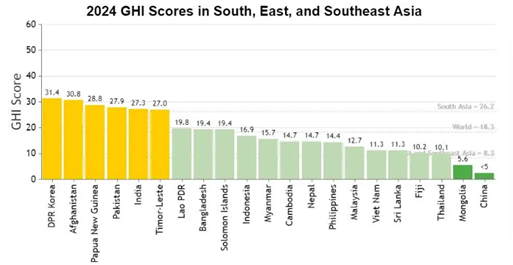TAG: GS-3: ECONOMY
THE CONTEXT:
The 19th Global Hunger Index (GHI) report for 2024 has ranked India 105th among 127 countries.
EXPLANATION:
Highlights of the 19th GHI 2024:
- India is ranked 105th out of 127 countries in the Global Hunger Index (GHI) 2024, indicating a ‘serious’ hunger situation.
- India lags behind its South Asian neighbours like Sri Lanka, Nepal, Myanmar, and Bangladesh but ranks above Pakistan and Afghanistan.
- India’s 2024 GHI score is 27.3, reflecting a serious level of hunger.
- This is an improvement from 2016 (score of 29.3) but still shows serious hunger problems.
- India’s previous scores were 38.4 in 2000 and 35.2 in 2008, both categorized as ‘alarming’. Hence, India has made progress over time but still struggles with serious hunger issues.
Theme: The theme for the 2024 Global Hunger Index (GHI) is “How gender justice can advance climate resilience and zero hunger”.
What is the GHI?
- The GHI is a peer-reviewed annual publication designed to comprehensively measure and track hunger at global, regional, and national levels, reflecting multiple dimensions of hunger over time.
- Created in 2006, the GHI was initially published by the US-based International Food Policy Research Institute (IFPRI) and Germany-based Welthungerhilfe. In 2007, the Irish NGO Concern Worldwide also became a co-publisher.
- In 2018, IFPRI withdrew from the project and the GHI became a joint project of Welthungerhilfe and Concern Worldwide.

- The GHI is intended to –
- Raise awareness and understanding of the struggle against hunger,
- Provide a way to compare levels of hunger between countries and regions, and
- Call attention to those areas of the world where hunger levels are highest and where the need for additional efforts to eliminate hunger is greatest.
Global hunger statistics:
- Globally, hunger reduction has stagnated since 2016, making achieving Zero Hunger by 2030 increasingly unlikely. The score is 18.3, a slight improvement from 2016’s of 18.8.
- Out of the 127 countries, 42 continue to face either ‘alarming’ or ‘serious’ hunger problems. 2.8 billion people cannot afford a healthy diet.
India vs. Neighbours:
- When compared to neighbouring countries like Sri Lanka, Nepal, and Bangladesh – each of which has fewer economic resources – India’s performance on the GHI is particularly alarming.
- This indicates that economic growth alone does not necessarily lead to improved nutritional outcomes.
-
- Sub-Saharan Africa: Highest rates of malnutrition and child mortality globally and ongoing conflicts in Somalia and Sudan exacerbate hunger crises.

- Issues:
- Difficulties in achieving SDG 2 (Zero Hunger by 2030): The GHI 2024 reveals that 42 countries face alarming or serious hunger levels, marking a stagnation in the fight against hunger despite decades of progress.
- Gender disparity: Women are particularly vulnerable to food insecurity due to discriminatory norms and violence, limiting their access to resources.
- A call to action:
- The GHI 2024 underscores the urgent need for coordinated efforts to address the intersecting crises of climate change, armed conflict, gender inequality and economic instability.
- It emphasises the importance of supporting vulnerable populations, particularly women, in the fight against hunger.
Addressing Hunger and Malnutrition in India:
- India has the highest child wasting rate globally, at 18.7%.
- The child stunting rate stands at 35.5%.
- The under-five mortality rate is 2.9%.
- Prevalence of undernourishment in India is 13.7%.
- Although child mortality has improved significantly since 2000, child undernutrition (wasting and stunting) remains a severe public health issue.
Effective policy interventions including key focus areas such as:
-
- Food security: Ensuring access to nutritious food for all segments of the population is essential.
- Healthcare access: Improving healthcare infrastructure can significantly impact maternal and child health outcomes.
- Maternal and child nutrition programs: Investing in targeted nutritional programs for mothers and children is vital for breaking the cycle of malnutrition.
Some initiatives in India:
- National Food Security Act (NFSA),
- PM POSHAN Scheme, etc.
SOURCE:
Spread the Word
